Egbert van Heemskerck the Younger stands as a notable figure in the lineage of Dutch genre painting, active during the latter half of the Dutch Golden Age and extending his career into early 18th-century London. Born into an artistic family, he followed in the footsteps of his father, developing a distinct, albeit related, style focused on the lively, often coarse, aspects of everyday life. His work provides a fascinating window into the social customs, entertainments, and even the anxieties of his time, rendered with a characteristic blend of realism, humor, and occasionally, the bizarre. While perhaps not reaching the towering heights of some contemporaries, his paintings and the prints made after them found considerable favour, particularly in England, where he spent his later years.
Formative Years in Haarlem
Egbert van Heemskerck the Younger entered the world in Haarlem, a vibrant centre of Dutch art, around 1645. He was the son of the painter Egbert van Heemskerck the Elder (often referred to as "Old Heemskerck"), establishing an immediate connection to the art world. His formal training is understood to have been under Pieter de Grebber, another Haarlem artist. However, despite this tutelage, the younger Heemskerck's artistic inclinations remained closer to the style and subject matter favoured by his father, suggesting a powerful familial influence that shaped his artistic trajectory from early on.
It is worth noting, as the historical sources themselves point out, that some confusion exists regarding the Heemskerck lineage. While generally identified as the son of Egbert the Elder, some accounts associate him with the more famous 16th-century painter Maarten van Heemskerck, or mention conflicting details about his father's birth date (sometimes cited as c. 1610). This ambiguity underscores the challenges in reconstructing the precise details of his early life and underscores the strong association between the Heemskerck name and Dutch painting across generations. Regardless, the paternal artistic environment was clearly foundational.
Artistic Identity: Style and Subject Matter
The Tavern and the Countryside
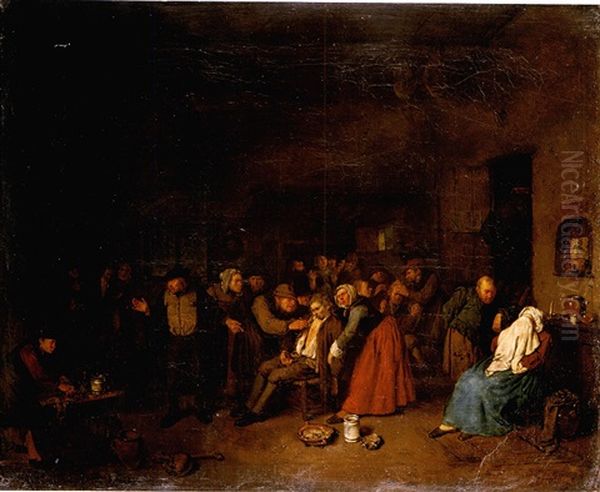
Heemskerck the Younger carved a niche for himself depicting scenes of peasant life, taverns, and rustic entertainments. His canvases often teem with activity, portraying villagers engaged in drinking bouts, card games, rural sports, and sometimes, outright brawls. These scenes are rarely mere observations; they are imbued with a robust, often earthy, sense of humour and satire. He captured the boisterous energy of these gatherings, not shying away from the less refined aspects of human behaviour. Interestingly, he is known to have occasionally painted himself into these lively compositions, perhaps as a wry observer participating in the very world he depicted.
A Touch of the Strange
Beyond the everyday realism of tavern interiors and village fairs, Heemskerck's work sometimes veered into the peculiar and the fantastical. Sources note his penchant for incorporating "visions, ghosts, and supernatural phenomena" into his paintings. This infusion of the bizarre adds another layer to his work, distinguishing it from straightforward genre painting. It suggests an interest in folklore, popular superstitions, or perhaps a desire to inject an element of moral commentary or sheer imaginative fancy into his scenes, lending them a unique and sometimes unsettling quality.
Technical Approach and Palette
Art historical assessments often describe Heemskerck the Younger's style as somewhat "cold" and "heavy." While acknowledging his inventiveness and creativity in subject matter and composition, critics point to a relative weakness in his handling of colour. His palette is often seen as lacking the warmth or subtlety found in the works of other Dutch masters. This characteristic contributes to a certain robustness, even harshness, in his paintings, which aligns with the often rough-and-tumble nature of the scenes he portrayed. His technical execution, therefore, presents a contrast: imaginative in conception but perhaps less refined in chromatic expression.
Focus on Specific Themes
Medicine and Science
A significant and intriguing aspect of Heemskerck the Younger's oeuvre is his depiction of medical scenes. Works like The Doctor's Surgery (created between 1665-1675) offer vivid, if somewhat grim, portrayals of contemporary medical practices. These paintings go beyond simple documentation; they convey the tension and rudimentary nature of surgery in the 17th century. Such works suggest more than a passing interest in the subject, reflecting perhaps a deeper understanding of medical knowledge for a layman of his time and certainly a keen observation of the professions and scientific advancements (or lack thereof) shaping his world. These scenes can be read as commentaries on human vulnerability, the state of science, and the drama inherent in life-and-death situations.
Social and Religious Commentary
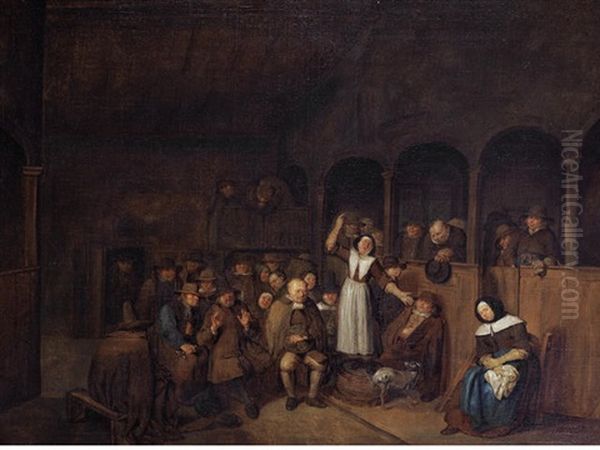
Heemskerck also turned his attention to contemporary social and religious groups, most notably in his depictions of Quaker meetings. Several paintings on this theme are known, which later served as the basis for popular prints. These works, such as Quakers' Meeting, provide valuable visual records of these gatherings during a period when the group faced scrutiny and misunderstanding. His portrayal, while potentially carrying the satirical edge common in his work, offers insight into the religious diversity and tensions of the time, particularly in England where the Quakers were a significant presence. His interest extended to philosophical themes as well, indicated by works potentially depicting figures like Heraclitus and Democritus, suggesting an engagement with broader intellectual currents.
Web of Influences
The Shadow of the Father and the Legacy of Maarten van Heemskerck
The most immediate and defining influence on Egbert the Younger was undoubtedly his father, Egbert van Heemskerck the Elder. The stylistic similarities between father and son are so pronounced that attribution has often been difficult, with works sometimes confused in auction catalogues and collections. This strong paternal legacy shaped his choice of subject matter – the peasant genre scenes – and his general approach. Some sources suggest the elder Heemskerck may have travelled to Italy, absorbing influences from the Italian Renaissance, particularly Romanism (a style blending classical elements with Northern European traditions), which could have been indirectly transmitted to his son.
Further complicating the lineage, as mentioned, some sources connect the family line or artistic heritage back to the highly significant 16th-century Dutch painter Maarten van Heemskerck. Maarten van Heemskerck was a pivotal figure who studied with Jan van Scorel and later travelled extensively in Italy, becoming a key proponent of Romanism in the North. If Egbert the Younger descends from or was artistically linked to this lineage, it places him within a major tradition of Dutch art that engaged directly with Italian Renaissance ideals, even if his own work focused on more vernacular themes. The precise nature of this connection remains debated in some accounts.
Dutch Traditions
Beyond his family, Heemskerck the Younger operated firmly within the broader tradition of Dutch Low Country genre painting. This style, flourishing in the 17th century, celebrated scenes of everyday life, often with a moralizing or humorous intent. Artists like Adriaen Brouwer and Adriaen van Ostade specialized in similar peasant and tavern scenes. Heemskerck's emphasis on humour, satire, and detailed observation aligns perfectly with this dominant trend in Dutch art, which found a ready market both domestically and abroad. His work reflects the Dutch fascination with depicting their own society in all its facets.
Grebber's Guidance
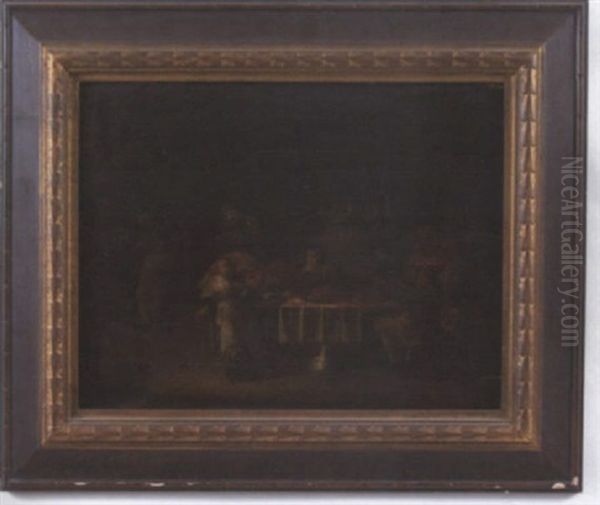
While his father's style seems dominant, the influence of his teacher, Pieter de Grebber, cannot be entirely dismissed. De Grebber was a respected Haarlem painter associated with the local school of classicism, influenced by the Utrecht Caravaggisti and aware of masters like Peter Paul Rubens and Rembrandt van Rijn. Although Heemskerck the Younger's rougher genre scenes differ significantly from Grebber's more polished historical and religious paintings, his formal training under Grebber would have provided him with foundational skills in drawing, composition, and technique, even if he ultimately chose a different artistic path.
A Career Across the Channel
Arrival in England
At some point, likely during the reign of King James II, Egbert van Heemskerck the Younger made the significant move from the Netherlands to England. He settled in London, becoming part of a community of Dutch and Flemish artists working in the British capital. His arrival coincided with a period of considerable cultural exchange between the Low Countries and Britain. He continued to work and gained recognition, particularly after the ascension of the Dutch King William III to the English throne, an event that further strengthened ties between the two nations.
Patronage and Life in London
In London, Heemskerck found patrons who appreciated his distinctive style. Notably, he received support from John Wilmot, the 2nd Earl of Rochester, a prominent courtier and poet known for his libertine lifestyle – perhaps finding a kindred spirit in Heemskerck's often bawdy subject matter. (Some sources mention Robert, Earl of Chester, possibly indicating confusion or multiple patrons). He seems to have integrated into the London art scene, continuing to produce his characteristic genre paintings. His presence in London contributed to the popularity of Dutch-style genre scenes among English collectors. He remained in London until his death in 1704, reportedly at the age of fifty-nine or sixty-one according to different accounts.
Significant Works
Heemskerck the Younger's body of work includes numerous paintings and drawings, many focusing on his preferred themes. Among his notable or representative works are:
The Doctor's Surgery (c. 1665-1675): A prime example of his medical scenes, showcasing a tense surgical procedure with dramatic lighting and characterization. Its dimensions are recorded as approximately 64 x 25 inches.
Country Fair: A typical depiction of rural life, capturing the bustling atmosphere of a village market. One such work, measuring 70.8 x 91.2 cm, carried an auction estimate of €2000-€3000, indicating the market value of his paintings.
Quakers' Meeting: Several versions exist, depicting the distinctive religious gatherings of the Society of Friends. These became well-known through engraved versions, reflecting contemporary interest in and sometimes suspicion of the group.
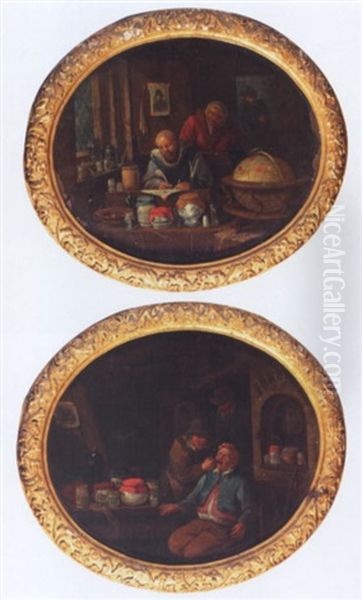
Interior Scene (Tavern Scene): Numerous works fall under this category, often featuring drinkers, smokers, and card players in dimly lit interiors. One example noted for its exaggerated expressions and dramatic, almost Caravaggesque lighting, highlights his skill in capturing atmosphere and character.
Anonymous Dutch Print after Richard Brakenburgh (c. 1675-1700): While not by Heemskerck himself, the existence of prints based on paintings by artists like Richard Brakenburgh (another Dutch genre painter) relates to the milieu in which Heemskerck worked and the dissemination of such imagery through printmaking, a field Heemskerck was also involved in.
Contemporaries and Connections
Egbert van Heemskerck the Younger's career intersected with, or can be compared to, several key figures in art history:
Egbert van Heemskerck the Elder: His father, the primary influence on his style and subject matter.
Maarten van Heemskerck: The renowned 16th-century painter possibly linked through lineage or confused identity, representing the earlier Romanist tradition in Haarlem.
Pieter de Grebber: His teacher in Haarlem, connecting him to Dutch classicism and artists influenced by the Utrecht Caravaggisti, Peter Paul Rubens, and Rembrandt.
Jan van Scorel: Teacher of Maarten van Heemskerck, representing the introduction of Italian Renaissance ideas into the Netherlands.
Richard Brakenburgh: A fellow Dutch genre painter whose work was reproduced in prints, indicating shared themes and markets.
Rembrandt van Rijn: The towering figure of the Dutch Golden Age. Heemskerck's work, particularly its "cold" and "heavy" aspects, stands in contrast to Rembrandt's profound psychological depth and mastery of light, though Grebber's connection provides an indirect link. Rembrandt himself was influenced by Caravaggio.
Johannes Vermeer: The Delft master known for his serene interiors and exquisite handling of light. Vermeer, also influenced by Caravaggio and Rembrandt, offers a stark contrast to Heemskerck's boisterous and often cruder scenes.
Utrecht Caravaggisti: Painters like Hendrick ter Brugghen and Gerrit van Honthorst, whose dramatic light and shadow techniques influenced Pieter de Grebber, thus indirectly filtering into Heemskerck's artistic background.
These connections place Heemskerck within a complex web of artistic inheritance, training, and contemporary practice, highlighting both his adherence to established Dutch genre traditions and his distinct position within that landscape, particularly during his later career in England.
Art Historical Perspective
Evaluation
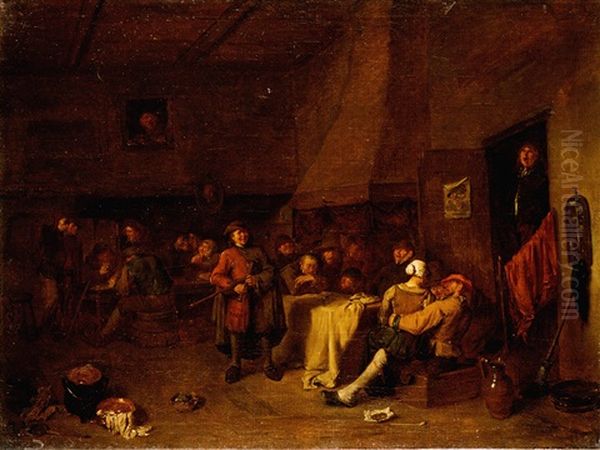
Art historians generally position Egbert van Heemskerck the Younger as a competent and often engaging painter within the Dutch Low Country genre tradition, but not typically as an innovator of the first rank. His reputation is often overshadowed by that of his father (or the more famous Maarten van Heemskerck, depending on the lineage interpretation) and certainly by the giants of the Dutch Golden Age like Rembrandt and Vermeer. His style is sometimes characterized as imitative, particularly of his father, and lacking in significant development or originality. However, his skill in capturing the energy of peasant life and his willingness to incorporate humour, satire, and the bizarre are acknowledged strengths.
Influence and Reception
Despite critical reservations about his originality, Heemskerck's work found a receptive audience, especially in 18th-century England. As the taste for grand Dutch landscapes perhaps waned slightly, genre scenes like his, depicting relatable, albeit rough, human activity, became popular among British collectors. His move to London facilitated this, making his work readily available. The prints made after his paintings, particularly the Quakers' Meeting, further disseminated his imagery and contributed to contemporary social and religious discourse. He played a role in popularizing Dutch genre themes within the English art market.
Legacy
Egbert van Heemskerck the Younger's legacy lies primarily in his contribution to genre painting, offering vivid, albeit stylized, glimpses into 17th and early 18th-century life in both the Netherlands and England. His works serve as valuable social documents, reflecting customs, pastimes, professional activities (like medicine), and social types. His focus on humour and satire provides insight into popular tastes and attitudes. While hampered by some ambiguity regarding his biography and perceived limitations in technique compared to the greatest masters, he remains a distinctive voice, a chronicler of the everyday whose work continues to offer interest for its energy, subject matter, and historical context. He represents a fascinating bridge between Dutch artistic traditions and the developing art scene in London.